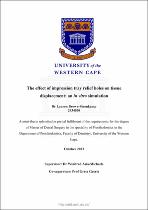| dc.contributor.advisor | Asia-Michaels, Winifred | |
| dc.contributor.author | Brown-Steenkamp, Lauren | |
| dc.date.accessioned | 2024-03-11T10:02:56Z | |
| dc.date.available | 2024-03-11T10:02:56Z | |
| dc.date.issued | 2024 | |
| dc.identifier.uri | http://hdl.handle.net/11394/10666 | |
| dc.description | Magister Chirurgiae Dentium - MChD | en_US |
| dc.description.abstract | Background:
Mobile fibrous tissue can cause excessive movement of a complete denture during function,
causing discomfort for the patient. Extensive tissue displacement during definitive impression
making can have a direct impact on the anatomical form on which the complete denture will
be fabricated. When displaced mobile fibrous tissues return to their relaxed state, dislodgment
forces might work against the denture base. As a result, the manner in which the tissues are
recorded is critical to the retention and durability of the complete denture. The addition of relief
holes to the custom tray allows impression material to escape and decreases the pressure
exerted to the underlying alveolar tissue, hence minimizing tissue displacement.
Aim of the study:
To assess the degree of simulated fibrous tissue displacement on edentulous maxillary
analogues when three dimensional (3D) printed custom impression trays with various relief
hole sizes and quantities are utilised during a one-step secondary impression technique. To
achieve this aim, impressions were digitally analyzed by superimposing the 3D digital control
and test models for quantitative analysis utilising metrology software. | en_US |
| dc.language.iso | en | en_US |
| dc.publisher | University of the Western Cape | en_US |
| dc.subject | Impression tray | en_US |
| dc.subject | Relief hole | en_US |
| dc.subject | Simulation | en_US |
| dc.subject | Tissue displacement | en_US |
| dc.title | The effect of impression tray relief holes on tissue displacement: an in vitro simulation | en_US |
| dc.rights.holder | University of the Western Cape | en_US |

